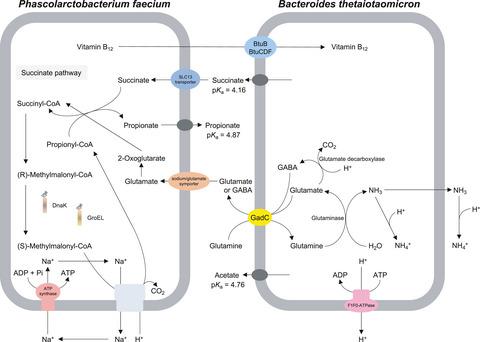当前位置:
X-MOL 学术
›
Microbiologyopen
›
论文详情
Our official English website, www.x-mol.net, welcomes your
feedback! (Note: you will need to create a separate account there.)
Microbial interaction between the succinate-utilizing bacterium Phascolarctobacterium faecium and the gut commensal Bacteroides thetaiotaomicron.
MicrobiologyOpen ( IF 3.9 ) Pub Date : 2020-08-28 , DOI: 10.1002/mbo3.1111 Nao Ikeyama 1 , Takumi Murakami 2 , Atsushi Toyoda 2 , Hiroshi Mori 2 , Takao Iino 1 , Moriya Ohkuma 1 , Mitsuo Sakamoto 1, 3
MicrobiologyOpen ( IF 3.9 ) Pub Date : 2020-08-28 , DOI: 10.1002/mbo3.1111 Nao Ikeyama 1 , Takumi Murakami 2 , Atsushi Toyoda 2 , Hiroshi Mori 2 , Takao Iino 1 , Moriya Ohkuma 1 , Mitsuo Sakamoto 1, 3
Affiliation

|
A large variety of microbes are present in the human gut, some of which are considered to interact with each other. Most of these interactions involve bacterial metabolites. Phascolarctobacterium faecium hardly uses carbohydrates for growth and instead uses succinate as a substrate. This study investigated the growth behavior of the co‐culture of the succinate‐specific utilizer P. faecium and the succinogenic gut commensal Bacteroides thetaiotaomicron. Succinate production by B. thetaiotaomicron supported the growth of P. faecium and concomitant propionate production via the succinate pathway. The succinate produced was completely converted to propionate. This result was comparable with the monoculture of P. faecium in the medium supplemented with 1% (w/v) succinate. We analyzed the transcriptional response (RNA‐Seq) between the mono‐ and co‐culture of P. faecium and B. thetaiotaomicron. Comparison of the expression levels of genes of P. faecium between the mono‐ and co‐cultured conditions highlighted that the genes putatively involved in the transportation of succinate were notably expressed under the co‐cultured conditions. Differential expression analysis showed that the presence of P. faecium induced changes in the B. thetaiotaomicron transcriptional pattern, for example, expression changes in the genes for vitamin B12 transporters and reduced expression of glutamate‐dependent acid resistance system‐related genes. Also, transcriptome analysis of P. faecium suggested that glutamate and succinate might be used as sources of succinyl‐CoA, an intermediate in the succinate pathway. This study revealed some survival strategies of asaccharolytic bacteria, such as Phascolarctobacterium spp., in the human gut.
中文翻译:

利用琥珀酸的细菌粪便Phascolarctobacterium和肠道共生细菌Thetaiotaomicron之间的微生物相互作用。
人类肠道内存在多种微生物,其中一些被认为会相互影响。这些相互作用大多数涉及细菌代谢产物。粪杆菌杆菌几乎不使用碳水化合物来生长,而是使用琥珀酸盐作为底物。这项研究调查了特定于琥珀酸盐的利用者P共培养的生长行为。屎肠球菌和肠道succinogenic共生的多形拟杆菌。B生产琥珀酸酯。thetaiotaomicron支持P的增长。粪便并通过琥珀酸途径伴随产生丙酸酯。产生的琥珀酸酯完全转化为丙酸酯。该结果与P的单培养相当。粪便中添加了1%(w / v)琥珀酸盐的培养基。我们分析了P的单培养和共培养之间的转录反应(RNA-Seq)。屎肠球菌和乙。太太微米。的基因的表达水平的比较P。粪便在单培养条件和共培养条件之间的差异突出表明,在共培养条件下明显表达了琥珀酸转运的基因。差异表达分析表明P的存在。粪便引起B的变化。蛋白质的转录方式,例如维生素B 12转运蛋白基因的表达变化和谷氨酸依赖的耐酸系统相关基因的表达减少。另外,对P进行转录组分析。粪便提示谷氨酸和琥珀酸酯可以用作琥珀酸辅酶A的来源,琥珀酸CoA是琥珀酸途径的中间体。这项研究揭示了人类肠道中糖酵解细菌(例如Phascolarctobacterium spp。)的一些生存策略。
更新日期:2020-10-17
中文翻译:

利用琥珀酸的细菌粪便Phascolarctobacterium和肠道共生细菌Thetaiotaomicron之间的微生物相互作用。
人类肠道内存在多种微生物,其中一些被认为会相互影响。这些相互作用大多数涉及细菌代谢产物。粪杆菌杆菌几乎不使用碳水化合物来生长,而是使用琥珀酸盐作为底物。这项研究调查了特定于琥珀酸盐的利用者P共培养的生长行为。屎肠球菌和肠道succinogenic共生的多形拟杆菌。B生产琥珀酸酯。thetaiotaomicron支持P的增长。粪便并通过琥珀酸途径伴随产生丙酸酯。产生的琥珀酸酯完全转化为丙酸酯。该结果与P的单培养相当。粪便中添加了1%(w / v)琥珀酸盐的培养基。我们分析了P的单培养和共培养之间的转录反应(RNA-Seq)。屎肠球菌和乙。太太微米。的基因的表达水平的比较P。粪便在单培养条件和共培养条件之间的差异突出表明,在共培养条件下明显表达了琥珀酸转运的基因。差异表达分析表明P的存在。粪便引起B的变化。蛋白质的转录方式,例如维生素B 12转运蛋白基因的表达变化和谷氨酸依赖的耐酸系统相关基因的表达减少。另外,对P进行转录组分析。粪便提示谷氨酸和琥珀酸酯可以用作琥珀酸辅酶A的来源,琥珀酸CoA是琥珀酸途径的中间体。这项研究揭示了人类肠道中糖酵解细菌(例如Phascolarctobacterium spp。)的一些生存策略。











































 京公网安备 11010802027423号
京公网安备 11010802027423号